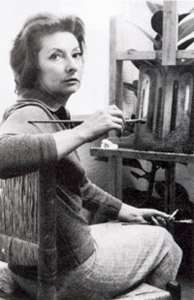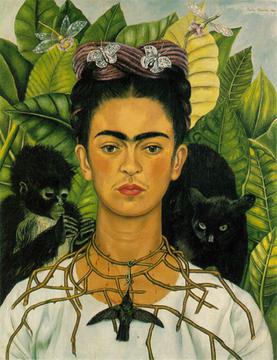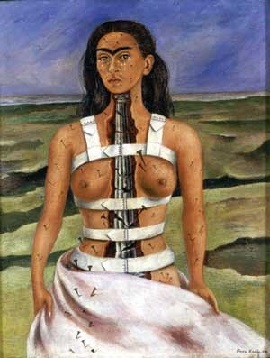
Magdalena Carmen Frida Kahlo y Calderón was a Mexican painter known for her many portraits, self-portraits, and works inspired by the nature and artifacts of Mexico. Inspired by the country's popular culture, she employed a naïve folk art style to explore questions of identity, postcolonialism, gender, class, and race in Mexican society. Her paintings often had strong autobiographical elements and mixed realism with fantasy. In addition to belonging to the post-revolutionary Mexicayotl movement, which sought to define a Mexican identity, Kahlo has been described as a surrealist or magical realist. She is also known for painting about her experience of chronic pain.

Penelope Rosemont is a visual artist, writer, publisher, and social activist who attended Lake Forest College. She has been a participant in the Surrealist Movement since 1965. With Franklin Rosemont, Bernard Marszalek, Robert Green and Tor Faegre, she established the Chicago Surrealist Group in 1966. She was in 1964-1966 a member of the Industrial Workers of the World (IWW), commonly known as the Wobblies, and was part of the national staff of Students for a Democratic Society (SDS) in 1967-68. Her influences include Andre Breton and Guy Debord of the Situationist International, Emma Goldman and Lucy Parsons.

Frida is a 2002 American biographical drama film directed by Julie Taymor which depicts the professional and private life of the surrealist Mexican artist Frida Kahlo.

Pascale Petit, is a French-born British poet of French, Welsh and Indian heritage. She was born in Paris and grew up in France and Wales. She trained as a sculptor at the Royal College of Art and was a visual artist for the first part of her life. She has travelled widely, particularly in the Peruvian and Venezuelan Amazon and India.

María de los Remedios Alicia Rodriga Varo y Uranga was a Spanish surrealist painter working in Spain, France, and Mexico.

Minotaure was a Surrealist-oriented magazine founded by Albert Skira and E. Tériade in Paris and published between 1933 and 1939. Minotaure published on the plastic arts, poetry, and literature, avant garde, as well as articles on esoteric and unusual aspects of literary and art history. Also included were psychoanalytical studies and artistic aspects of anthropology and ethnography. It was a lavish and extravagant magazine by the standards of the 1930s, profusely illustrated with high quality reproductions of art, often in color.

Jacqueline Lamba was a French painter and surrealist artist. She was married to the surrealist André Breton.

Alice Phillipot (Alice Rahon) (8 June 1904 – September 1987) was a French/Mexican poet and artist whose work contributed to the beginning of abstract expression in Mexico. She began as a surrealist poet in Europe but began painting in Mexico. She was a prolific artist from the late 1940s to the 1960s, exhibiting frequently in Mexico and the United States, with a wide circle of friends in these two countries. Her work remained tied to surrealism but was also innovative, including abstract elements and the use of techniques such as sgraffito and the use of sand for texture. She became isolated in her later life due to health issues.

Women Surrealists are women artists, photographers, filmmakers and authors connected with the surrealist movement, which began in the early 1920s.

The Two Fridas is an oil painting by Mexican artist Frida Kahlo. The painting was the first large-scale work done by Kahlo and is considered one of her most notable paintings. It is a double self-portrait, depicting two versions of Kahlo seated together. One is wearing a white European-style Victorian dress while the other is wearing a traditional Tehuana dress. The painting is housed at the Museo de Arte Moderno in Mexico City.

Self-Portrait with Thorn Necklace and Hummingbird is a 1940 self-portrait by Mexican painter Frida Kahlo which also includes a black cat, a monkey, and two dragonflies. It was painted after Kahlo's divorce from Diego Rivera and the end of her affair with photographer Nickolas Muray.

The Wounded Deer is an oil painting by Mexican artist Frida Kahlo created in 1946. It is also known as The Little Deer. Through The Wounded Deer, Kahlo shares her enduring physical and emotional suffering with her audience, as she did throughout her creative oeuvre. This painting in particular was created towards the end of Kahlo's life, when her health was in decline. Kahlo combines pre-Columbian, Buddhist, and Christian symbols to express her wide spectrum of influences and beliefs.

The Broken Column is an oil on masonite painting by Mexican artist Frida Kahlo, painted in 1944 shortly after she had spinal surgery to correct on-going problems which had resulted from a serious traffic accident when she was 18 years old. The original is housed at the Museo Dolores Olmedo in Xochimilco, Mexico City, Mexico.

Frieda and Diego Rivera is a 1931 oil painting by Mexican artist Frida Kahlo. This portrait was created two years after Frida Kahlo and Diego Rivera married, and is widely considered a wedding portrait.

The Frame is a 1938 self-portrait by Frida Kahlo. The painting is notable as the first work by a 20th-century Mexican artist to be purchased by a major international museum, when it was acquired by The Louvre in 1939. The painting is now shown at the Musée National d'Art Moderne in the Centre Pompidou in Paris.

Memory, the Heart, a 1937 painting by the Mexican artist Frida Kahlo, depicts the pain and anguish Kahlo experienced during and after an affair between her husband, artist Diego Rivera, and her sister, Cristina Kahlo.

Two Nudes in a Forest is an oil painting by Mexican painter Frida Kahlo that was completed in 1939. It is also referred to as The Earth, Two Nudes in the Wood, or My Nurse and I. The painting was given to a close woman companion of Kahlo's, who some believe to be actress Dolores del Río. The two women in the painting also appear in Kahlo's 1938 painting What the Water Gave Me, and her spider monkey, which views the couple from the forest, also appears in Kahlo's 1937 Fulang-Chang and I.

Henry Ford Hospital is a 1932 oil-on-metal painting by the Mexican artist Frida Kahlo about her experience of delivering a dead male fetus on 4 July at Henry Ford Hospital in Detroit, Michigan, United States, when she was approximately 31⁄2 months pregnant. Depictions of childbirth, abortion, or miscarriage are rare in the canon of Western painting, and Kahlo is "one of the only major artists to directly communicate her reproductive grief through visual art." The "bloody and terrifying" painting opened a defining and influential era of Kahlo's career. The painting's first title was The Lost Desire. An alternate title is The Flying Bed.

Self-Portrait Dedicated to Leon Trotsky, also known as Between The Curtains, is a 1937 painting by Mexican artist Frida Kahlo, given to Leon Trotsky on his birthday and the 20th anniversary of the October Revolution. Kahlo and her husband, artist Diego Rivera, had convinced government officials to allow Trotsky and his second wife, Natalia Sedova, to live in exile in Mexico. The Russian couple moved into the Blue House (La Casa Azul), where they resided for two years.
Self-portrait in a Velvet Dress is a 1926 oil-on-canvas painting by Mexican artist Frida Kahlo.



















